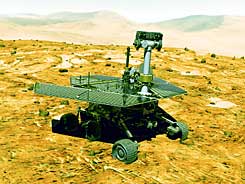The Opportunity rover has not been able to climb out of a sandy crater it has been exploring since landing on Mars almost two months ago

The six-wheeled vehicle skidded back when its operators tried to pull it out of the sandy crater. The dry sand and an angle of 16 degrees caused the vehicle's wheels to spin without moving, according to NASA's Jet Propulsion Laboratory.
The mission controllers are planning another attempt to get out of the crater on Monday - to drive the vehicle diagonally across the slope.
"We know that the vehicle can do such things," said the project manager, Richard Cook. "There are many variations on how to do this before we start to worry. Opportunity has had problems before when sliding into the crater but they were not as serious as the stop on Sunday. Cook said.
Opportunity landed in a crater about 25 meters in diameter on January 25. Half a Mars away the Spirit, Opportunity's twin explores the bottom of a much larger crater. Today (Tuesday) NASA plans a press conference where it plans to announce an "important scientific finding" in the Mars mission. The scientists are expected to provide more details about the wet conditions in which the rocks examined at the two landing sites formed.
For the news on the Yahoo news site, 22/3/04 at 21:30 p.m
You don't drive in the dark, you don't drive fast and in the meantime there are no traffic jams - that's how it is on Mars
Jerry Garrett, New York Times, Haaretz, Walla!
Pasadena, California. Currently, there are no traffic jams on Mars that could affect the daily routine of John Wright, an engineer at NASA's Jet Propulsion Laboratory in Pasadena, California. Wright's daily driving routine also includes spending time in front of the "Spirit" control panel, whose price - about 414 million dollars - makes any SUV, no matter how luxurious, look cheap.
But even when the expensive vehicle is under his control, Wright is not the most careful driver: while the spacecraft explores the surface of Mars, Wright watches television, plays on the computer, attends staff meetings, chats on the cell phone and even visits the bathroom.
If a scenario arises in your imagination, according to which Spirit and his twin brother - "Opportunity" - will try to "seize command" and refuse the orders sent to them from Earth, you can remove worry from your heart: the vehicles do not have the ability to think for themselves. The scientists designed it for purposes that require relatively weak computer power: weaker than the power of a common laptop. The planners wanted something simple and light enough, so that it could be carried for a distance of about 56 million km, in a spaceship powered by a rocket fuel tank.
It turns out that the "less is more" formula, a theory from the world of computers, works better on Mars than the "more is more" formula, which was recently tried on Earth. As part of a competition held in the USA last weekend, in which unmanned vehicles participated, there was also a vehicle designed by some of the same NASA scientists, which was not limited by the power of its computer or its weight. However, the same vehicle managed to make it only a few kilometers before it crashed, on its way from California to Nevada.
On the other hand, despite the "less is more" formula, Spirit did not work as expected in its first forays on Mars. "The problem was similar to the problem known from the home computer," explains Wright. "His hard drive was full." Once the control team figured out how to clear its memory, control of the vehicle was restored.
A Martian day lasts 20 minutes longer than a day on Earth, and during the mission the crew members live according to Martian time. Every day, they come to work later and later. "Even on days off, you have to stay on Mars time," Wright explains, "so you get to visit a lot of restaurants that are open all night and watch a lot of weird movies on the cable channels."
Many of the lab scientists have fast sports cars. It is possible that their need to drive fast increases after whole days of driving at speeds less than 1.6 km/h. Wright admits, however, that Spirit can move faster if necessary; "For example, if we have to cement it against local Martians who will try to capture it."
The vehicles, which weigh about 175 kg each, go out to explore the surface of Mars only during the daytime. "We could also drive at night," says Wright, "but we didn't install headlights, so we would have certainly collided with all kinds of things, and without garages in the vicinity, a collision is out of bounds." A driver who causes a crash will likely lose his interplanetary driver's license, and more importantly - the shirt worn by each of the nine drivers. On the front of the shirt is written "Rover Driver", and on the back side is printed a skull that goes up in flames.
Spirit and Opportunity's mission to Mars is set to end when funding for the project runs out, or when the vehicles reach the end of their lives. "At this point, I guess we'll just turn off the lights, lock the doors and go do something else," Wright says.
The experience of driving the space vehicles on the NASA site
